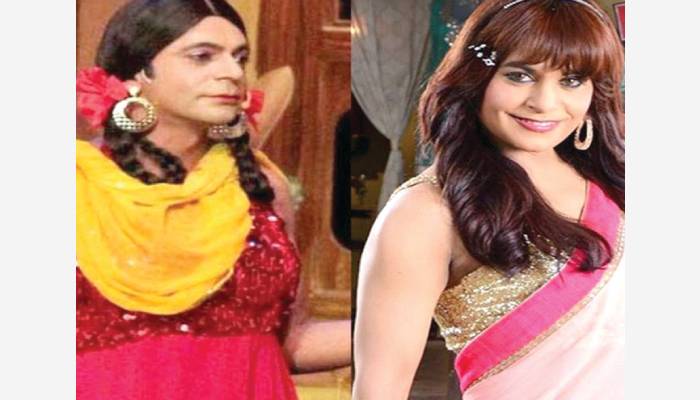
or

CERTAIN unique traits categorize popular fictional characters. These could be the name, the physical appearance, attitude, language that the characters embody but these unique characteristics can give pivotal recognition or popularity to any film or television programme. A character can often be the foundation on which sequels and spin-offs are produced by the original creator(s) or permitted licensees.
One such character has been of ‘Gutthi’, portrayed by Sunil Grover on the immensely popular show ‘Comedy Nights with Kapil’. Such was the popularity of ‘Gutthi’ that it sometimes upstaged the lead i.e., Kapil himself. Despite accolades and popularity, lack of recognition and acknowledgement by producers Viacom 18, Grover quit the programme and pitched the idea of having his own show to rival television channels. This irked Viacom 18, who issued a public notice warning that no attempt be made by anyone to portray ‘Gutthi’ or copy its mannerisms, claiming intellectual property rights over the character since the entire show is scripted.
It is not clear that to what extent the show is scripted or improvised. However, the matter of contention here is whether the right to “copy” the character on a different show where the character is played by the actor who had originally played it is a right of the actor or the producer.
The Indian Copyright Act contains an exhaustive list of copyrightable ‘works’ that include literary works. Therefore, if the portrayal of ‘Gutthi’ is in fact scripted as claimed by Viacom 18, then as per the definition of “works” under the Indian Copyright Act, the ownership of the character created in a literary work i.e. the script, belongs to Viacom 18. But, in order to be protected by copyright, a character (in this case ‘Gutthi’ developed and portrayed by Grover prior to being used in the show) in itself would also need to fall within thedefinition of one of the listed types of copyright ‘works’ i.e., literary, dramatic, musical work or artistic work; cinematographic film or a sound recording.
As I understand the controversy, it is centred around the important issue of copyrightability of characters played by artists and whether the intellectual property rights lie with the artist or the producer.
Sometime back channel Colors and production house Viacom 18 issued a public notice in a national daily wherein Viacom 18 declared that the character ‘Gutthi’ is their intellectual property, and thus cannot be adapted for any other programme.
According to Sunil Grover, he has played ‘Gutthi’ on other TV shows prior to his stint on Comedy Nights with Kapil and Viacom18 was erroneously claiming that they had created ‘Gutthi’. The Copyright Act, 1957, under clause 2 of Section 38A lays down that the performers’ rights detailed in s. 38A(1) are enjoyed by the producers of a cinematographic film once an artiste’s performance is incorporated in the film, and the rights under s. 38A(1) include the right to make a sound or visual recording of the performance and the right to broadcast or communicate the performance to the public. However the problem is that the instant case involves an issue not directly covered by the Indian Copyright Act.
However, there is a decision of the Kerala High Court, which might be of help in interpreting the legalities of the present controversy. In Malayala Manorama v. V T Thomas [AIR 1989 Ker 49], the Kerala High Court, while deciding the issue of ownership of copyright on newspaper cartoon character held that the publishing house could not restrain V T Thomas, a cartoonist from continuing to draw the cartoons after leaving its employment. This is because the characters had been created by V T Thomas before joining Malayala Manorama and the publishing house had no role in the creation of the characters. The publishing house was also restrained from drawing the cartoons after terminating V.T. Thomas’ employment. However, the Court made an important distinction between ownership of the characters per se and ownership of the cartoon strips and as such laid down that the ownership of the characters per se was a right vesting in the cartoonist, the ownership of the cartoon strips would be considered property of the publishing house.


Drawing an analogy from the above decision and the fact that in the present case ‘Gutthi’ had already been played by Sunil Grover prior to Comedy Nights with Kapil means that the producers did not play a role in the creation of the character and, therefore, in my limited knowledge, would not be able to claim ownership over ‘Gutthi’.
However, it is commonly accepted that a character is not a dramatic work (since a character as such does not constitute a performance), nor a literary work (even though the character is normally described in writing in the script and so might be thought of as a literary work. It does not appear to be the intention of the Copyright Act to give a character a separate literary copyright). In light of this, it is pertinent to also understand the intention of Clause 2 of Section 38A of The Copyright Act, 1957, which states: “Once a performer has, by written agreement, consented to the incorporation of his performance in a cinematograph film, he shall not, in the absence of any contract to the contrary, object to the enjoyment by the producer of the film of the performer’s right in the same film.”
This clause clearly outlines that the performers’ rights are solely owned by the producers of a cinematographic film and can be fully exploited in any manner by the producer once an artist’s performance is incorporated in the film. This intention has also been upheld in Fortune Films International v. Dev Anand case. Further, the subject to the interpretation of this clause and, as publicly claimed by Viacom 18, Grover was working for the producers on a work-for-hire basis whereby all rights generate in his performance are owned by Viacom making them the author of the work. This in itself leads one to conclude that the character ‘Gutthi’ is owned by Viacom 18, with a power to exploit it any manner whatsoever and that the exploitation of the character by any third party will amount to infringement.
However, in contradiction to the theory detailed above, Kerala High Court in Malayala Manorama v. V T Thomas [AIR 1989 Ker 49] decided that a publishing house could not restrain the cartoonist from continuing to draw the cartoons after leaving employment and injuncted them from claiming ownership over the characters created by the cartoonist before joining the publishing house. This is because the characters had been created by the cartoonist before joining the publication and the publishing house had no role in the creation of the characters. The publishing house was also restrained from drawing the cartoons after terminating the cartoonist’s employment.
The Kerala High Court did not highlight the issue of the right of a character to afford a copyright but it decided the issue of ownership of copyright on character and to this end one may agree that copyright on character could be claimed successfully by the cartoonist as well. This case allows us to assume the distinction made by the court between ownership of the characters per se and ownership of the works created with the character while he was gainfully employed by the producer; and determines that while the former is a right vested with Grover, the latter would be the property of the producers.
Although this case is unique and equally favourable to influence both sides of the argument, the crucial aspect is the reality that the character ‘Gutthi’ had already been played by Grover prior to being made part of ‘Comedy Nights with Kapil’. This means that the producers did not play a role in the creation of the character and therefore, would most likely not be able to claim ownership over it.
Copyright assures authors the right to their original expression, but encourages others to build freely upon the ideas conveyed by a work. These principles hold equally true in the context of copyright protection for characters within a work. A character is an aggregation of the particular talents and traits his creator selected for him and it is these traits that qualify as unique elements of expression, not simply basic ideas. To substantiate this hypothesis some courts have adopted a “character delineation” test to help them decide whether fictional characters deserve copyright protection. This test analyzes whether a fictional character is developed specifically enough to warrant protection of the character as copyrightable expression or instead, does the character’s description only describe a character type that it is nothing but an idea and thus undeserving of copyright protection.
Therefore, to warrant copyright protection, a fictional character must be specifically described and fully developed. Given the absence of copyright protection for literary fictional characters, rights holders should carefully consider alternative methods to protect their characters. Trademark and passing-off are alternative distinct bodies of law that could provide some protection for fictional characters from unauthorised use in sequels.
Irrespective of the outcome of this issue, an owner of a graphic or fictional character should implement a legal strategy that overlaps the protections provided by various areas of law. This is because courts are still inconsistent with regard to the specific body of intellectual property or unfair competition law that provides a character protection. This legal strategy should cover trademark, unfair competition, copyright, and contract law. Once in place, this strategy should be monitored to ensure that rights do not lapse due to failure to renew at a proper time. The content that one protects should also be monitored for possible infringement or dilution, and the rights that have been acquired must be enforced.
If Viacom 18 decides to take further legal action, this case will be a landmark dispute between “acquired personality right” of an actor with a “reel character” and the trademark/common law right of the producer in the “reel character” assigned to a contracted actor. This in turn draws attention to the importance of sophisticated “artist contract” with actors and safeguarding character names by timely filing trademark applications, securing domain names and named accounts with popular social media websites.
Pralika works as legal counsel for CAA KWAN, a talent management agency for Bollywood.

Lex Witness Bureau

Lex Witness Bureau

Lex Witness Bureau

For over 10 years, since its inception in 2009 as a monthly, Lex Witness has become India’s most credible platform for the legal luminaries to opine, comment and share their views. more...
Connect Us:


The Grand Masters - A Corporate Counsel Legal Best Practices Summit Series
www.grandmasters.in | 8 Years & Counting
The Real Estate & Construction Legal Summit
www.rcls.in | 8 Years & Counting
The Information Technology Legal Summit
www.itlegalsummit.com | 8 Years & Counting
The Banking & Finance Legal Summit
www.bfls.in | 8 Years & Counting
The Media, Advertising and Entertainment Legal Summit
www.maels.in | 8 Years & Counting
The Pharma Legal & Compliance Summit
www.plcs.co.in | 8 Years & Counting
We at Lex Witness strategically assist firms in reaching out to the relevant audience sets through various knowledge sharing initiatives. Here are some more info decks for you to know us better.
Copyright © 2020 Lex Witness - India's 1st Magazine on Legal & Corporate Affairs Rights of Admission Reserved